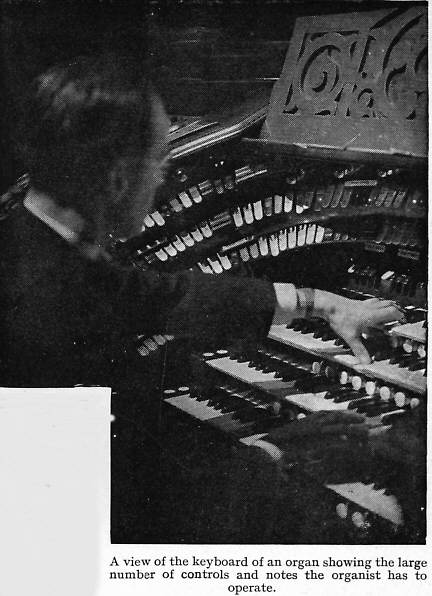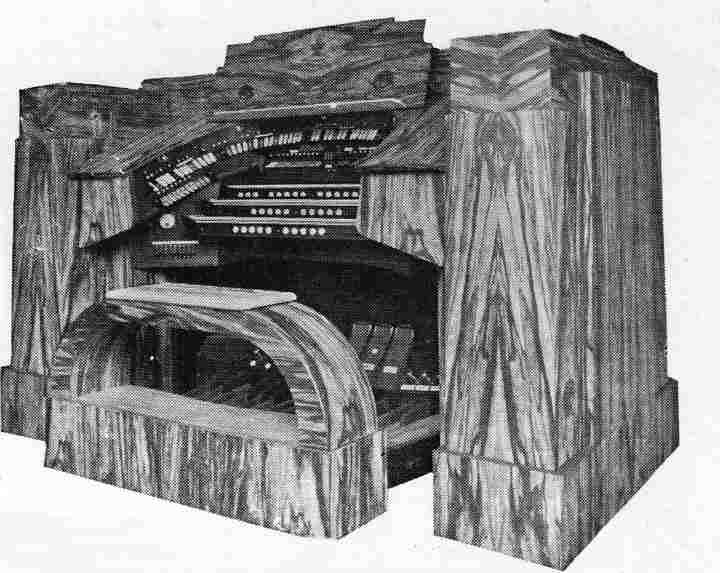
This article was first published in "Marvels of Modern Science" by F.J. Camm, London, approx. 1935, pages 159-164
Marvels of the Cinema Organ
How the Wonderful Effects are Obtained from a Device Which is the Nerve Centre of a Remarkable Electrical System.

The Console shown here is a three-manual "Christie" organ organ with a casework of wax-polished marble ebony. This unique and modern design was specially chosen to harmonise with the architectural surroundings of the theatre in which it was installed.
The adaptation of electrical mechanism to the organ has made vast strides in recent years. Many devices hitherto unthought of, have been brought into service, developed and perfected. The hundreds of pipes, percussions and effects can be sufficiently controlled from a comparatively small console placed at any reasonable distance from the organ itself, which is only made possible by this form of action. The production of new tone-colours featured in most modern organs and the improvement of those already in use is a never-ending quest, and the object of almost continuous experiment. The mechanism which makes it possible for one individual to operate so many different tone-colours and effects is necessarily of a very intricate nature. It involves many thousands of contacts, wires and soldered joints, besides hundreds of different points where circuits are controlled by multiplex switches devised for the purpose. The electro magnet is probably the most important unit in the organ's mechanism, as through its medium the action is ultimately set in motion. Of special design it is capable of forty repetitions a second, which is, of course, considerably faster than any human being can play.
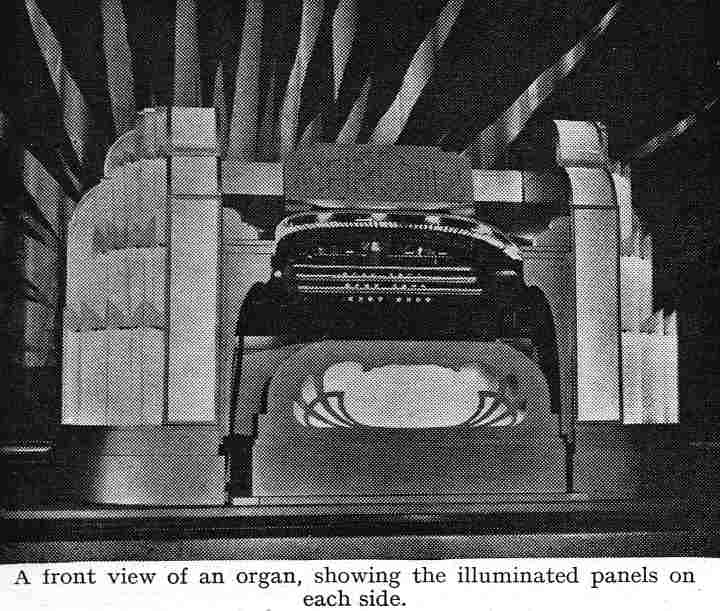
The electric contacts throughout the main relay and the console are made of standard silver and are housed in holders made of maple wood. The main cables between the console and the organ are of very strong construction, double - cotton covered, enamelled, bound, and finally insulated.
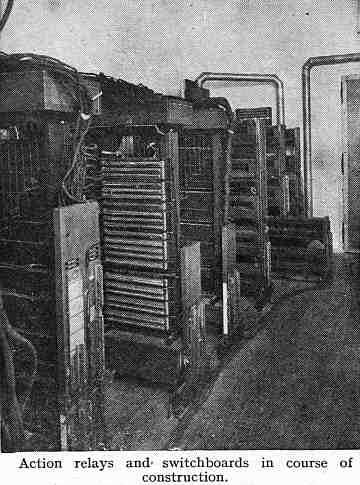
SECOND TOUCH CONTROL
In all but a few cases at least, two of the keyboards or manuals, as they are called, are fitted with second touch control. This means that by pressing through first touch to second touch, a second and quite distinct tone-colour or effect can be produced from the same rows of keys. Ten single- or double-touch thumb pistons are arranged under each row of keys, which make it possible for the organist by pressing any piston to alter immediately the combination of stops, and produce an entirely different effect. Furthermore, by means of a control board placed at the back of the console, any combination of stops can be arranged on these pistons at the will of the organist.
As a further means of control, each department of the organ is fitted with a cancel bar, by the depression of which all stop keys on that manual are immediately returned to the normal position, and all stops become dumb. By a complete system of coupling, any one manual can be connected to the pedal organ if required. A full range of orchestral effects is also controlled from the keyboard. These effects are distributed over the various manuals and the pedal board, and include drums, cymbals, triangle, Chinese block, castanets, etc., on the manuals.
SPECIAL INTERMANUAL COUPLERS
These couplers are fitted to various organs to augment the usual unison couplers, and are sometimes controlled by first or second touch. For instance, solo octave to accompaniment second touch, or accompaniment sub-octave to great first touch, enable the organist to produce quite unique effects. The Pizzicato key control is capable, in the hands of an experienced organist, of producing effects which are bewildering to the listener. The pluck of a string or the lipping of a trumpet can be imitated, effects which, but for this device, would be impossible. From this, it will be seen, that these expression controls at the organist's fingertips bring almost any imaginable effect within range.
Beside the control of the various organ tone-colours, wood-wind, brass, etc., there are also provided suitable controls for percussions, drums, and other effects. Placed in either the solo or accompaniment chamber of the organ, these percussions and effects are operated by electro-pneumatic action.
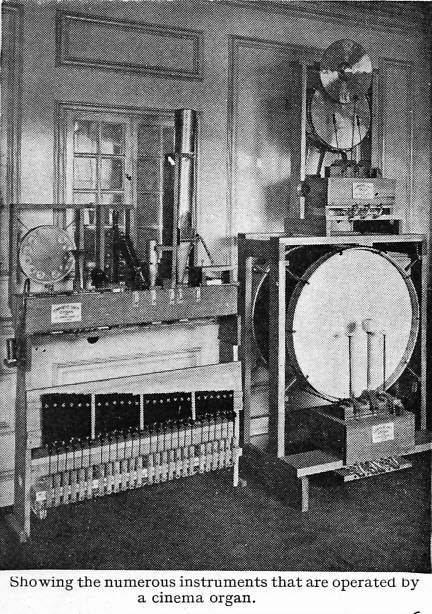
The drum-sticks, for example, are attached to pneumatic motors operated by electro magnets, which work with such rapidity as to produce the snare drum or bass drum roll. The former drum is controlled by the manual keys, and as long as the key is depressed, the drum will keep on rolling. The bass drum, cymbal crash, triangle, etc. are controlled from the pedal keys. The same principle is used for tonal percussions, such as a harp, marimba, xylophone, glockenspiel, chimes, vibraphone, and chrysoglot. Some require a single blow. others, such as the xylophone and glockenspiel, are fitted with a reiterating action as well as a single action. Other effects, such as surf, telephone bell, bird whistle, syren, boat whistle, etc., are operated by stop keys in a special position over the solo keys. The consoles are fitted with crescendo pedal indicators, a clock and a voltmeter. The external casework is designed in association with the theatre architect to suit the architectural scheme of the theatre. Almost unlimited designs are available. The console is usually placed on a rise-and-fall platforrn in the orchestral enclosure.
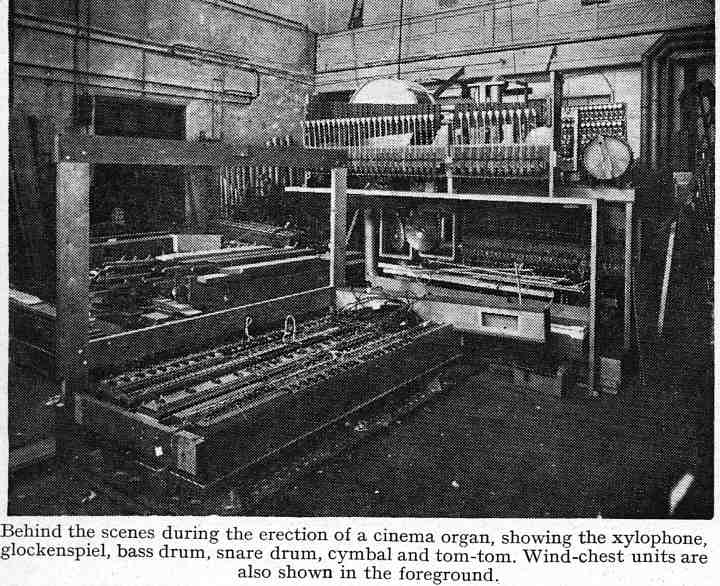
TONE-COLOURS
The number of different tone-colours in an organ depends, of course, on its size and the requirements of the theatre. It does not follow, however, that an overpoweringly loud organ is large, as certain fundamentals must form the basis of all properly drawn up theatre organ specifications, otherwise power, balance and dignity will be sacrificed. Given the fundamentals, a specification can be enlarged to almost any extent, in order to secure variety of tone. Solo stops, such as clarinet, oboe, vox humana, saxophone, French horn, English horn, trumpet and tuba, all go to build up a truly magnificent instrument capable, through the controls mentioned above, of almost any variation of tone.
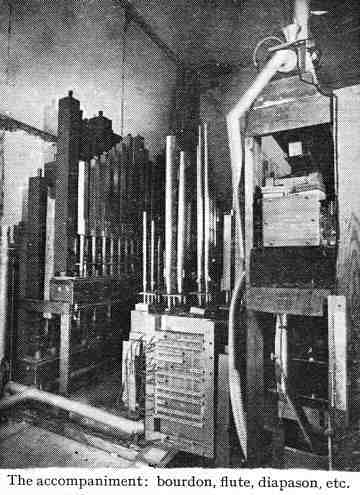
Diapasons, strings, flutes, diaphone and diapason basses, augmented by reeds, produce the fundamental organ tone, and by use of the unit system of construction, which is general throughout all Christie organs (which illustrate this chapter), these fundamental ranks are fully extended to form bass and treble registers of suitable strength and balance. The treatment and voicing of this side of the instrument is an all-important and delicate task, because besides being fundamental, some of the stops are also accompanimental.
VOICING
This is the art of making the pipes 'speak' . When the pipes are received by the voicer, they are quite 'dumb' and no sound whatever can be obtained from them.
Voicing is a very delicate job, and is divided into three quite distinct departments: flute stops, reed stops, and tonal percussions. In flute stops, the tone is produced on much the same principle as in a tin whistle; but in reeds, the tone is produced in various forms of reed made of carefully selected brass, vibrating against a brass 'shallot'. Percussion tone is produced from the actual instruments themselves, which consist of metal or wooden bars of different sizes, fitted with resonators. The bars are struck by specially made hammers. Under the heading of flute stops, are such stops as tuba, open diapason, viol d'orchestra, flute, celeste, etc. By manipulation of the lip, languid and windway, the pipes are made to speak, and through the medium of a voicing machine, which is really a miniature organ, each one is treated, but to pitch length, and balanced against its neighbour. Every stop in the organ is sealed and voiced for the particular theatre in which it is to be installed. In the voicing of reeds, among which are the clarinet, oboe, saxophone, tuba and trumpet, the operation is more complicated and intricate. The reed voicer is responsible for selecting the brass for the ' tongues ' , for cutting it to the exact shape and size required, and for so curving each 'tongue' and ' loading' it, as to produce the tone required by the voicer .
TONAL STRUCTURE AND SCALES
The power and balance of a theatre organ are dependent to a large extent on the scale of the various stops which go to make up the specification; wind pressures also play a large part, and Christie organ scaling is very large and the wind pressures employed are high. Scale is the organ builder's term for diameter , and the expression 7-inch scale means that the lowest' C' of the stop measures 7 inches across the top. When the specification of the organ has been decided upon, it is a tonal specialist's business to set down against each stop the scale to which it shall be made. He has as many as twenty or more scales in one stop alone from which to select, and from this it will be seen that the scaling of an organ requires experience and judgment. In unit organ construction where numerous tone-colours are secured from comparatively few ranks of pipes, the specification can be very deceptive.
THE POSITION OF THE ORGAN
In order to obtain the best results from any organ, the question of position must be considered. The finest and most complete organ can be ruined by accommodating it in the wrong place. The organ ' voicer ' can however, overcome to an appreciable extent many of the acoustic and physical difficulties sometimes encountered, but this rarely can be done without sacrificing some of the delicacy and purity of tone. The line sketches on page 162 show the four most likely positions for organ chambers, namely: divided, one on each side of the proscenium ; over the proscenium; under the stage; and on one side of the proscenium. The Christie Unit Organ, which is the subject of this chapter, is manufactured by Wm. Hill & Son and Norman & Beard, Ltd., to whom we are indebted for the above information. Taking the four positions in the order mentioned, the first is suitable for a large organ of, say, from 10 to 15 units upwards, that is if there is not too great a distance between the organ chamber. A small organ of 9 units, or under, would prove very unsatisfactory, however, because, if the building is narrow and the sound openings are placed close to the screen, the listener would hear the solo disembodied from the accompaniment by the width of the proscenium.
The second position, namely, over the proscenium, will prove effective in most theatres, its success depending on a short sound duct being as near the screen as possible. Confused tonal results would be caused by a long and badly shaped sound duct, and the more delicate tones of the organ will fail to reach the rear of the auditorium beneath the circle, if the outlet is high above the screen.
An organ under the stage is suitable for a short, wide theatre. Sound will appear to come from the screen, but care must be taken to provide ample sound openings and sufficient height, otherwise the organ will be 'bottled ' and a poor crescendo result. The sound openings, however, must be suitably placed, otherwise the organist sitting in the centre of the orchestra enclosure in the full stream of sound is apt to misjudge the volume.
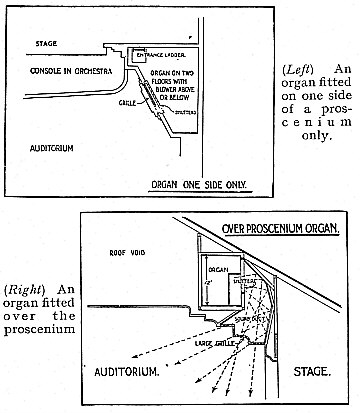
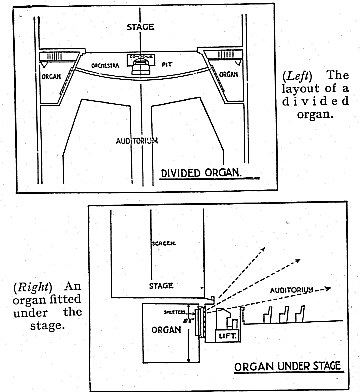
MOST SATISFACTORY POSITION
An organ placed on one side of the proscenium is considered the most satisfactory position, particularly if the grille is kept at a moderate elevation so that the sound can easily travel under the circle. Two organ chambers arranged one above the other are much to be preferred. With this arrangement, a narrow grille, which usually assists the general decorative scheme, can be used with success. The theatre organ is essentially a product of modern times, but without the use of all the fundamental principles of organ-building science, no organ, whatever purpose it may be required to serve, can be successful or reliable. In the Christie organ these principles are applied and maintained.
Whether it be in the selection of timber, the making of pipes, the manufacture of the electro-pneumatic action, or in voicing and finishing, these essential principles are rigidly observed.
